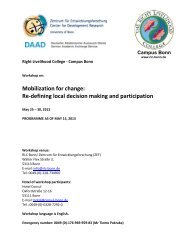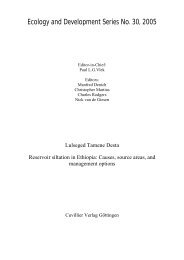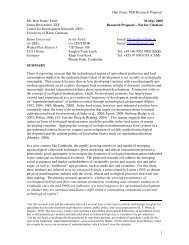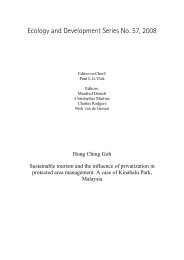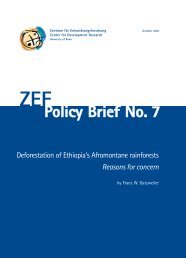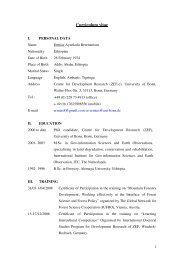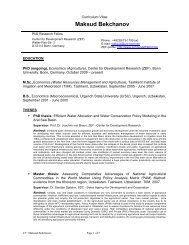Karuna Trust, Karnataka - ZEF
Karuna Trust, Karnataka - ZEF
Karuna Trust, Karnataka - ZEF
You also want an ePaper? Increase the reach of your titles
YUMPU automatically turns print PDFs into web optimized ePapers that Google loves.
Good and Bad Practices in Microinsurance<strong>Karuna</strong> <strong>Trust</strong>, Indiasubsidiaries still coordinate policy baselines in a committee of state-run insurance groups, theGeneral Insurance Public Sector Association (Swain 2000).To date, besides the four state-run companies, the Export Credit Guarantee Corporation andAgricultural Insurance Company, eight private insurance companies are registered in generalinsurance. Since the private insurers are reluctant to enter the health sector, the state-runcompanies still dominate the market. On average, health insurance has grown at a rate of 40%in the three years following 1999 and therefore is the fastest growing segment in the generalinsurance market. It is expected that health insurance will become the second largest generalinsurance class after motor insurance (The Economic Times of India 2002).The Most Popular Health Insurance ProductsThe most popular private, voluntary health insurance product in India is Mediclaim, whichhas been offered by all four state-run insurers since 1986. Mediclaim reimburses the costs ofhospital stays and home care up to an individually determined sum (Bhat/Mavalankar 2000).Pre-existing diseases and AIDS are excluded from coverage (Gumber 2002).The premium depends on the sum covered (between Rs. 15,000 ($340) and Rs. 500,000($11,363)) and the age of the insured person (Bhat/Babu 2003). Like premiums paid toprivate insurance companies, the Mediclaim premium is income-tax deductible(Ranson/Jowett 2003). The state thereby subsidises 20-40% of the premium(Bhat/Mavalankar 2000). Mediclaim policies are available for individuals, families or groups.Depending on group size, considerable premium discounts are offered (Gumber 2002). Forinstance, a large employer who insures over 50,000 employees can receive a group discountof 30% plus a commission of 5%, i.e. an overall reduction of 35% (Krause 2000).Benefits are paid as reimbursements of submitted prepaid bills (Ellis/Alam/Gupta 2000). Thepatient is free to choose a health care provider as long as certain requirements are met, suchas a minimum number of beds.Following the example of private providers, the state-run insurers have recently begun to useThird Party Administrators (TPAs) to service their clients. They look after policyholders,guide them in choosing services, and pay for the services on behalf of the insurer, therebyenabling the client to receive a cashless service. TPAs are profit-seeking companies thatentered the recently liberalised market at the intersection of insurers, clients and health careproviders. Besides counselling policyholders, on behalf of insurance companies TPAsmonitor health services and billing by keeping in close contact with health care providers(IRDA 2002). They also have to register with the IRDA.The Mediclaim product, which was used by 10 million Indians in 2004/05 (Cahill/Matthies),does not yet perform in a cost-effective way for the insurance companies (Gumber 2002).Claim settlement rates and administration costs result in loss rates of 130-140%(Nagendranath/Chari 2002), casting doubts on the long-term sustainability of Mediclaim inthe face of increasing competition for middle and higher income groups. Variations ofMediclaim, such as a travel health insurance or the Unimedicare policy for lower and middleincomegroups offered by the UIIC, were introduced to help the state-run companiespenetrate the health insurance market.7



